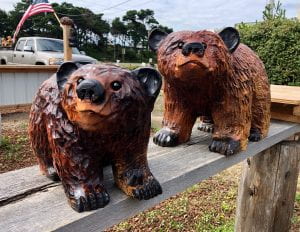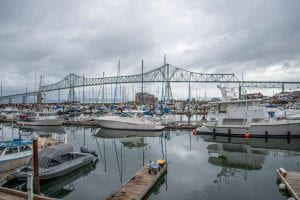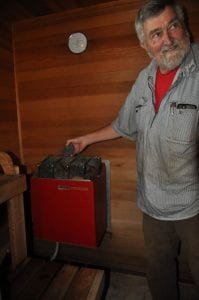UO Folklore graduate students Christal Snyder and Iris Teeuwen conducted fieldwork in Clatsop County with OFN Director, Riki Saltzman, and contract folklorist Douglas Manger (August 23-25, 2019). Christal Snyder also accompanied Saltzman and contract folklorist Joe O’Connell (UO Folklore alumni) in Lincoln County, August 9-11.
In Clatsop County, we observed Finnish traditions, foodways, and seaways, while in Lincoln County we experienced chainsaw carving, the Siletz Pow-Wow, and waterways traditions. Those interactive and behind-the-scenes experiences that folklorists in the field get to experience are priceless. We are most grateful to the UO Folklore and Public Culture program, which funded our graduate student fieldwork internship travel expenses.
Lincoln County: August 9-11
Christal and Riki met up with Joe in Seal Rock (Lincoln County), where we interviewed Karl Kowalski, a second-generation chainsaw carver. Karl’s shop was rich with history and fun to photograph. He quickly warmed up to us and had an engaging sense of humor. By way of explaining how he got started in this business, Karl told us that his father managed a sideshow attraction behind a shop full of whimsical chainsaw carvings. While Karl devotes most of a room of his shop to his father’s carvings, his own designs possessed a character of their own. Everywhere you look, there are carved bears of all shapes and sizes as well as other critters scattered throughout the shop. Each of Karl’s creatures has a personality of its own.





The next day Christal, Riki, and Joe got an early start and attended the annual Nesika Illahee Pow-Wow, which began with a parade. Members of the Confederated Tribe of Siletz Indians wore their traditional handmade regalia, walked or rode in artfully decorated cars, and threw candy and other treats to the crowds stretched along the parade grounds.



Next, we headed to the Pow-Wow. The rich smell of fried, grilled, and stewed food drew us to the vendor area that encircled the Pow-Wow grounds. We had to try out the local Indian tacos, made of fresh fry bread piled with sautéed ground beef and topped with chopped onions, salsa, and tomatoes. Craft vendors were interspersed with food booths, and folks from tribes near and far sold jewelry, hand-tooled leatherwork, traditional clothing, and more; a Navajo woman was selling intricate beadwork.
The afternoon’s formal events opened with a salute to the flag; veterans lead the procession as the Pow-Wow MC asked everyone to stand and remove their hats. A series of different dances for different age groups and genders followed.


Several drum groups took turns accompanying the dances and setting the rhythm.


On our last day in Lincoln County, we strolled along the fishing docks and then visited the Pacific Maritime Heritage Center in Newport. There we wandered through a fascinating exhibit on shrimping, a larger room that detailed the heritage of Oregon’s northern coast, halls full of local paintings, and a beautiful space for public events and screenings. It also allowed us to learn more about the region, and we found out that surfing has a long history in the area. We connected with executive director, Steve Wyatt, who was as enthusiastic as we were about developing future partnerships.


Astoria – Clatsop Co: August 23-25, 2019
Iris Teeuwen and Christal Snyder accompanied Riki Saltzman to Astoria (August 23-25), which is situated at the mouth of the Columbia River. We met up with folklorist Douglas Manger, who had been contracted to document traditions in Clatsop County, among others. Our time with Douglas was packed with hands-on opportunities.

Our first stop was the Columbia River Maritime Museum, where we met with assistant curator, Matthew Palmgren. Palmgren gave us historical background on the region and took us through a huge warehouse full of historic fishing boats.


After a tour of the archives and a stop at the Museum gift shop, we drove over to Andy Carlson’s house and fish-smoking shed where we interviewed Carlson and grandson Aleks Matthews about Finnish traditions. Douglas asked Iris and Christal to take the lead interviewing Aleks about Finnish saunas, a traditional feature of most Finnish- American homes in Astoria. Aleks told us about visiting his grandparents every Sunday for traditional food and family time in the sauna. We truly valued the experience of coming up with questions on the spot, a skill that all folklore fieldworkers must learn. We got to tour Andy’s sauna and smokehouse, and he put out a generous spread of his smoked salmon, tuna, and elk for us to sample. While we ate, Andy told us stories about what it was like to grow up Finnish-American in the area, which involved not only family gatherings but also a variety of community events—including concerts, plays, dances, and meals—at the Finnish Brotherhood’s Suomi Hall.





The next morning, we met with Beth Kondall, one of the skilled traditional bakers at Astoria’s Blue Scorcher Bakery. We had the opportunity to engage in participant-observation fieldwork by not only interviewing and photographing, Beth, but also helping Beth prepare a variety of Finnish pastries and breads. The highlight was braiding and glazing pulla, a traditional Finnish cardamom-flavored sweet bread traditionally served with coffee—a practice so customary that the rich bread is often called coffee bread. The next day, after serving us some pulla to go with our coffee, Beth gifted us with the loaves we had braided.





After our bakery visit, we drove over to Suomi Hall, the center for the historic Finnish Brotherhood in Astoria. There we interviewed Dea Helligso, Helen Pitkanen, and other women from the Finnish community about their traditions, history, and ancestors’ migration to northwest Oregon.


Next, we drove over to the Columbia River Bar Pilot office where we spoke with retired bar pilot, Robert Johnson. One of the most dangerous occupations in the world, bar pilots are responsible for taking ships from the Columbia River to the Pacific Ocean—over the ever-changing Columbia River Bar. A bar pilot has to know every inch of land and water, be able to read weather changes, and know whether or not to risk the dangerous crossing. Johnson has a lifetime full of fascinating information on maritime logistics and experiences, and his personal charisma makes him a compelling storyteller.





Douglas had to tear us away from our session with Robert Johnson to get to Helen Pitkanen’s house on time. A no-nonsense woman of many talents, Helen immediately put Iris and Christal to work to help her make a traditional Finnish rice pudding.


In between stints of stirring the thickening pudding, Helen showed us her paintings and her collections, including a handcrafted Finnish basket.

With full stomachs from enjoying Helen’s creamy rice pudding topped with her yummy cherry preserves, we went back to our hotel to rest up for the evening’s activities. Our new friends at Suomi Hall invited us to a local theatrical performance where we learned more about the early Finnish immigrants and their connection to Astoria’s fishing, canning, and logging industries.
We spent our final day in Brownesmead, where we interviewed Delwin Barnsde a net maker and mender, hunter, boat builder, and more. Barnsde spent his life fishing, and now lives in his handcrafted roundhouse on a tributary of the Columbia River. Besides fishing and net mending, a critical skill for fishermen, Barnsde is a hunter and a master duck decoy carver who has taught others this traditional craft.







Our Astoria weekend with Douglas Manger gave us a new perspective on fieldwork that we would have never gotten otherwise. Instead of simply observing or studying in a classroom, we got to experience conducting interviews and gained invaluable hands-on experience. All the tradition keepers we met were extremely kind and welcoming. We learned so much about their culture and traditions, and we left with fond memories of our time in the field as folklorists.
It is heartening to know the future of public folklore is in such good hands with the likes of Christal and Iris coming on. As one who typically works solo in the field, the opportunity to share the Astoria field experience with Riki Saltzman, director of Oregon Folklife Network, and two bright, enthusiastic emerging folklorists from the OFN program, was without question as enriching for me as (hopefully) it was for them. The notion of bringing students into the field for a first-hand experience is a must in my view. Thank you OFN for making this initiative possible.
Douglas Manger